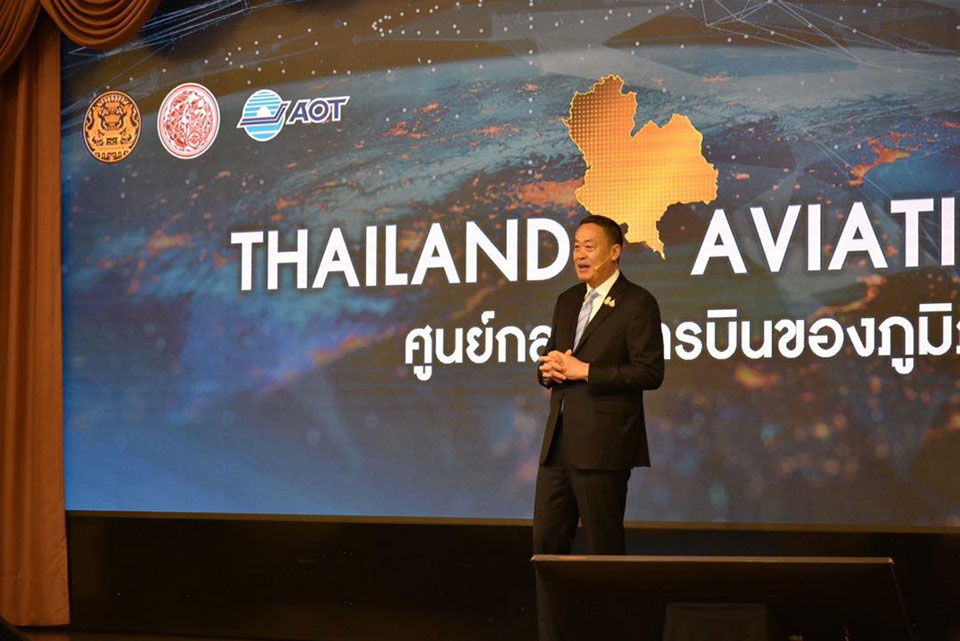
The Airports of Thailand Public Company Limited (AOT) is all set to support Thailand to become a global aviation hub connecting air transport and travel in Asia Pacific region according to the policies made by Prime Minister Srettha Thavisin on impelling Thailand to be ranked 1 of 20 best airports in the world, enhancing its capacity of handling international passengers more than 150 million passengers per year and becoming a 1 of 10 regional cargo destinations centre of the world.
Thailand has its potential of being an aviation hub, for it is geographically located in the middle of Asia Pacific region sharing borders with 3 neighbouring countries, as well as having rights and benefits from the liberalization of aviation.
As an airport operator, AOT supervises 6 airports, namely Suvarnabhumi Airport (BKK), Don Mueang International Airport (DMK), Chiangmai International Airport (CNX), Mae-Fah Luang Chiang Rai International Airport (CEI), Phuket International Airport (HKT) and Hat Yai International Airport (HDY). All these 6 airports are regarded as the front stage of creating an impression on tourists and supporting the air transport industry.
To achieve its set targets, AOT is absolutely determined to increase the capacities of its airports to accommodate the growing number of passengers in the future, link the airports with the other modes of transport across the country and develop other related industries to become a hub of travel in the region such as Maintenance Repair and Overhaul: MRO and Private Jet which are aimed at attracting airlines across the globe to open their new routes to Thailand and serving the Asia Pacific aviation market which grows by leaps and bounds.
At present, AOT accelerates its 10-year airport development master plan to ably handle 150 million passengers per year.
In 2023 BKK opened its Satellite 1 (SAT-1) to increase its capacity of accommodating passengers from 45 million to 60 million passengers per year. As for the year of 2024, BKK prepares for the opening of its 3rd runway to increase its capacity from 68 flights per hour to 94 flights per hour.
Additionally, AOT has airport development plans on a continuous basis. For example, the East and West Expansion project of the main Passenger Terminal aims to increase its passenger handling capacity to 30 million passengers per year. Another project is the South Terminal Construction which increases its passenger handling capacity to 60 million passengers per year. The airport development plans also include the 4th runway construction project which will enhance its potential of handling flights to 120 flights per hour.
Besides, AOT gears up to develop local airports to become regional aviation hubs in preparation for alleviating the congestion of air traffic movements of the country’s main airports, connecting the journey of tourists and distributing economic opportunities to secondary cities.
As for Don Mueang International Airport or DMK which is the secondary airport handling domestic and international flights, AOT plans to increase its capacity to accommodate passengers from 30 million to 50 million passengers per year. For example, the plans include the construction project of a new international passenger terminal, the renovation project of the existing passenger terminals, the “Junction Building” construction project which will be a large commercial area connected to the mass transit system of the Red Line Train, the development of an aircraft maintenance, repair and overhaul (MRO) centre in collaboration with the private sector, and the construction of a car park building which can accommodate 7,600 cars.
In the southern region where is the most concentrated tourism economy, AOT has plans to expand the capacity of Phuket International Airport (HKT), develop its expansion part of International Passenger Terminal and construct a new pier to increasing its capacity to handle 18 million passengers per year. This also includes the construction of second Phuket International Airport or known as Andaman Airport which will be able to additionally handle passengers to 40 million and has its potential to become a southern hub serving long-haul flights and direct international point-to-point flights.
In addition, AOT is also conducting a study of the Seaplane & Ferry Terminal development project to develop areas designated for landing and take-off of seaplanes to accommodate high-end passengers.
Moreover, the northern aviation hub also covers the first phase expansion project of Chiang Mai International Airport (CNX). For example, the construction of a new International Passenger Terminal and the renovation of existing Passenger Terminal which will increase the handling capacity to 16.5 million passengers per year. This also includes the construction of second Chiang Mai International Airport or known as Lanna Airport which will be able to accommodate 20 million passenger per year.
For Mae-Fah Luang Chiang Rai International Airport, the airport has its first phase development project by constructing a new Passenger Terminal to increase its capacity to handle 6 million passengers per year, in conjunction with encouraging the private sector to take part in developing MRO to provide comprehensive aircraft maintenance and repair services.
In addition, AOT has plans to take over the management rights of 3 regional airports, namely Udon Thani Airport, Buriram Airport, and Krabi Airport. The two former airports are located in the Northeast and the latter is located in the South. The three airports will be developed into gateways to neighbouring ASEAN countries.
In the northeastern region, Udon Thani Airport will connect to the Lao People’s Democratic Republic, while Buriram Airport will connect to the Kingdom of Cambodia. These are considered important components in driving Thailand to become an aviation hub for ASEAN.
As for Krabi Airport, it will help to alleviate the congestion of air traffic at Phuket Airport which reaches its full capacity. It also accommodates international flights from various regions of the world.
In addition to increasing its potential of passenger transport, AOT is committed to developing air cargo transport, together with expansion of cargo warehouses to accommodate over 3.5 million tons of cargo per year and construction of a warehouse near the second satellite terminal (SAT-2 Cargo).
This will be done in conjunction with the application of new technologies to improve cargo management efficiency, which will greatly expand the opportunities for Thai business operators to get access to the global market and attract leading global air cargo companies to invest in creating a regional air cargo distribution centre at Suvarnabhumi Airport.
Besides, AOT has plans for commercial activities in the areas surrounding Suvarnabhumi Airport in order to attract large businesses to establish storage and distribution facilities, as well as developing commercial areas.
In this connection, AOT has also implemented technology and innovation in the Common Use Passenger Processing System (CUPPS) to increase the efficiency of passenger services at all 6 airports, providing convenience and speed, as well as reducing waiting times and solving out the bottleneck problems to alleviate passenger congestion in peak hours.
These systems include:
(1) Common Use Terminal Equipment (CUTE), which facilitates and manages passenger check-in access through Airlines Application;
(2) Common Use Self Service (CUSS), which facilitates and manages passenger check-in access with a focus on self-service, eliminating the need for passengers to wait at check-in lines and allowing them to do their check-in in advance (subject to each airline’s conditions);
(3) Common Use Bag Drop (CUBD), which facilitates and manages baggage handling, allowing passengers to load their baggage onto the conveyor belt themselves;
(4) Passenger Validation System (PVS), which verifies passenger travel information to enhance airport security and facilitate airline operations in verifying passenger information and screening passengers for having access to specific areas based on system-defined conditions;
(5) Self-Boarding Gate (SBG), which streamlines the boarding process at departure gates for passenger convenience and speed;
(6) Individual Carrier System (ICS), which is a high-speed baggage handling system with high accuracy in baggage tracking and tracing;
(7) Auto Channel for e-Passport holders, increasing the passport control capacity from 5,000 passengers per hour to 10,000 passengers per hour;
(8) Automated People Mover (APM), an electric train connecting the passenger terminal to the SAT-1 building.
Moreover, AOT also provides services through a 5G network, offering passengers a new travel experience, such as AI (Artificial Intelligence) Robots, Biometric Facial Recognition Systems, Advanced Aviation Safety Systems, and Suspicious Object Detection Systems.
Moreover, AOT also focuses on improving the efficiency of ground handling services to accommodate the increasing number of passengers by widely opening bids for new operators to take part in services.
Apart from providing quality services to our customers, AOT also give importance to safety and security standards which are significant elements of leading forward to be a global aviation hub.
At present, all AOT 6 airports operate in compliance with the state’s provisions based on international standards. Our operational personnel are certified by the state, and equipment used by the safety and security departments is certified by Transportation Security Administration (TSA) and European Civil Aviation Conference (ECAC) which are international standard organizations of USA and Europe.
The airport development not only creates the economic opportunities but also lifts the quality of population’s life.
Media Release No. 12/2024, 1 March 2024
Corporate Communications Department,
Airports of Thailand Plc
Tel: 0 2535 5242, 0 2535 5245 Fax: 0 2535 5216
Email: [email protected]
Website: www.airportthai.co.th (TAT)








